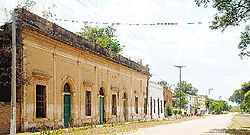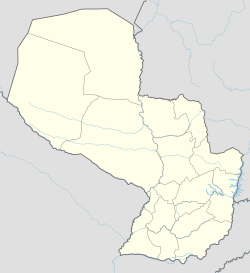Humaitá
Humaitá | |
|---|---|
 Colonial houses in Humaitá | |
| Coordinates: 27°4′12″S 58°30′0″W / 27.07000°S 58.50000°W | |
| Country | Paraguay |
| Department | Ñeembucú |
| Founder | February 1778 Pedro Melo de Portugal |
| Government | |
| • Intendente Municipal | Federico Cáceres Delgado |
| Area | |
| • Total | 389 km2 (150 sq mi) |
| Elevation | 44 m (144 ft) |
| Population (2008) | |
| • Total | 3,214 |
| • Density | 8/km2 (20/sq mi) |
| Time zone | -4 Gmt |
| Postal code | 2840 |
Humaitá is a town and district on the Paraguay River in southern Paraguay. During the Paraguayan War, it served as the main Paraguayan stronghold from 1866 until its fall in August 1868. Up to 24,000 troops were housed there at one point. It served as the de facto residence of the Paraguayan government until March 1868.
Being 275km south of Asunción, this is a Paraguayan city that has a great historical and cultural heritage with portions of the old fortifications, including some large earthworks, still visible. It also possesses the remains of a Jesuit church dating from the 18th century.
Toponymy[edit]
Humaitá comes from the Guaraní words “yma” (meaning ancient) and “itá” (meaning stone).
Geography[edit]
The predominant geography in the zone is a sheet of low areas, of whitish land, without prominent waviness. Due to the proximity of the Paraguay River, the increase of the waves overwhelms the whole bordering zone, therefore the geopolitical importance that the city had in the past.
Climate[edit]
The climate is subtropical, with temperatures reaching -2 °C in winter and 40 °C in the summer.
History[edit]


The remains of the old fortress of Humaitá are located on the left side of the Paraguay River, approximately 430 km to the south of Asunción. During the Paraguayan War (1864–1870) this fortress was important because it controlled river access to the capital, Asunción.
The defenses of Humaitá were begun by Carlos Antonio López (1790–1862). The ruins of the church and possibly the town museum are the only remains of the installation.
Economy[edit]
The inhabitants fish, raise cattle, and practice small-scale agriculture.
Local crafts include vases, gauntlets, pictures in burlap, and articles made from vegetable sponges. Carpets, tapestries, tablecloths, and crocheted apparel are also produced.
Transportation[edit]
Humaitá may be reached via Route 1 from Asunción, after reaching San Ignacio, take the detour to Pilar. Humaitá also may be reached through the new Villeta–Alberdi–Pilar Route[1][2][3]
One may also take the bus from Asunción to Pilar and transfer to an interurban bus that serves Humaitá.
Patrimony[edit]

The city has a rich historical patrimony. Humaitá was more involved than any other city in the Paraguayan War. The Paraguayan army used this city to contain the invasion by the Alliance. By the end of the war, the city had been wrecked by the invading troops.
The Cuartel de López, a museum in Francisco Solano López's former barracks, has three rooms where bullets, cannons, stirrups, spurs, swords, and other battlefield relics are displayed.
Tourism[edit]
Many tourists visit Humaitá. Students from all over Paraguay come to view the vestiges of the Paraguayan War, as do Uruguayan, Brazilian, Paraguayan and Argentine military men and civilians from throughout America and Europe.

- Ruins of Humaitá. Only a few vestiges survived bombardment by enemy cannons during the war. One of these was San Carlos Borromeo's church. Carlos Antonio López ordered its construction. It was inaugurated on January 1, 1861. At the time, it was considered one of the most beautiful in the Americas.
- Itapunta
- Curupayty
- Estero Bellaco
Hotels in the city include the Municipal Hotel, with Italianate architecture, constructed at the end of the 19th century. Many historians believe that Stroessner stayed there during the 1947 revolution.
Restaurants[edit]
A restaurant called The Terrace is located in the middle of the town square.
Fishing[edit]
Due to its location on the Paraguay River, Humaitá is also a popular place to fish. Fish such as Mandi'i, catfish, piranha, armado, duck, dorado, surubí, and pacú provide the main income of fishermen. Milanese surubí is a popular dish in local restaurants.
Gallery[edit]
-
A local church in Humaitá
-
Humaitá, Paraguay
-
Humaitá, Paraguay
-
Humaitá, Paraguay
Twin towns[edit]
Humaitá is twinned with:
 Malbrán, Argentina
Malbrán, Argentina
References[edit]
Sources[edit]
- World Gazeteer: Paraguay[dead link] – World-Gazetteer.com * Revista Zeta





